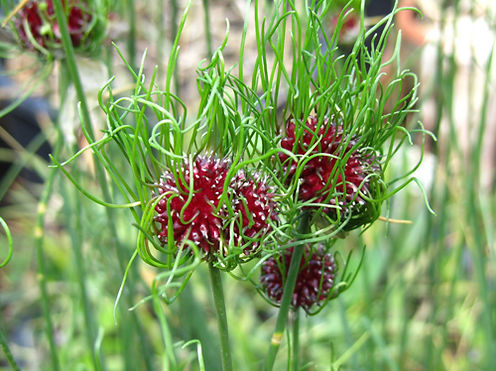Park Activities
Calendar of Events
Volunteer Programs
Sky Meadows Park
Location
Geography
Habitats
Trails
Visiting Park
Crooked Run Valley
Special Projects

wild garlic (Allium vineale)
COMMON NAMES:
wild garlic
crow garlic
stag's garlic
field garlic
scallions
SCIENTIFIC SYNONYMS:
TAXONOMY: The currently accepted sientific name for wild garlic
is Allium vineale L. Of three subspecies of Allium vineale, only subspecies vineale occurs in Virginia.
The native wild onion (sometimes called 'wild garlic', Allium canadense) can be distinguished from wild garlic by the fibrous-matted outer coating on the bulb, flattened solid leaves, star-shaped pink or whitish flowers and an onion-like taste. In addition, wild onion does not produce dormant hard-coated underground bulblets, and its stem leaves are attached to the lower 1/5 of the stem.
NATIVE STATUS: Introduced, United States and Canada. Wild garlic arrived in America mixed in soil used for ballast on European ships. The weedy stowaway was dumped ashore to make room for the return cargo.
GENERAL BOTANICAL CHARACTERISTICS:
Habit: The smooth, waxy stems are erect, unbranched, slender and rounded, and can grow 1 to 3 1/2 feet high. Stems are solid, and become rigid with age.
Leaves: Basal leaves emerge from the bulb, and are 1/2 to 2 feet long, slender, smooth, hollow, and nearly round in cross section. Stem leaves are produced along the lower half of the stem, and are composed of a tubular sheath surrounding the stem and a smooth, hollow, grass-like blade. The blades are flattened at the base, but nearly round toward the end. The sheaths cover the lower half of the stem.
Flowers: Flowers and/or aerial bulblets are produced in dense spherical clusters (3/4 to 2 inches wide) at the tops of stems. Clusters are initially covered in a papery bract (spathe). Flowers are purplish to greenish (sometimes white), with 6 small petals, and are borne on short stalks above the bulblets. Aerial bulblets are commonly produced in place of some or all the flowers, and are oval or teardrop-shaped and very small (1/8 to 1/5 inch long). They are smooth, shiny, and often develop miniature, tail-like green leaves.
Fruit/Seed: From the flowers, 2-seeded fruits are produced in egg-shaped capsules. Seeds are 1/8 inch long, flattened on one side, dull black, and wrinkled.
Roots: The primary underground structure is a bulb (2/5 to 4/5 inch wide), which produces fibrous roots from the bottom surface. Bulbs are oval or rounded, and covered with a brittle, membranous, papery outer layer. Mature bulbs produce 2 types of underground bulblets at the base. Soft-coated bulblets (1/3 to 2/3 inch long) are white and teardrop-shaped, and can germinate the first autumn. Hard-coated bulblets (1/2 inch long) are light brown, oval and flattened on one side, and germinate the following spring or later.
REGENERATION PROCESS: Wild garlic reproduces by under-ground and aerial bulblets, and less frequently by seeds (plants in the northern part of the range rarely produce seeds).
HABITAT TYPES: Wild garlic is common in grain fields, pastures, meadows, lawns, gardens and waste places, as well as along roads, rivers and streams.
SITE CHARACTERISTICS: Wild garlic prefers full or partial sun. It is drought tolerant, and can grow in a variety of soil types ranging from heavy, wet soils to dry, sandy or gravelly soils.
SEASONAL DEVELOPMENT: Flowering occurs from May to June. After flowering, the leaves die back, and the flower stems may remain standing through the summer and into fall. Aerial and soft-coated bulblets can germinate the same season they are produced, while hard-coated bulblets remain dormant through the winter and germinate the following spring or within the next 1 to 5 years. Sometimes aerial bulblets germinate in the stem-top clusters while the stems are still standing.
GENERAL DISTRIBUTION: Wild garlic naturally occurs from Florida north to Maine (excepting New Hampshire) and extending west to Oklahoma, Kansas, and Nebraska. It does not naturally occur in the upper Plains states, southwest, or most of the Rocky Mountain states (except Montana). It does also occur in the Pacific Coast states.
SKY MEADOWS DISTRIBUTION: To be determined.
IMPORTANCE AND USES: The nectar of the flowers attracts small bees and flower flies. Insects feeding on the bulbs of Allium spp. (Onions) include the maggots of Delia platura (bean seed fly) and Delia antiqua (onion fly), while various Frankliniella spp. (Thrips) feed on the foliage. Although mammalian herbivores usually avoid this plant, it is sometimes eaten along with the grass by cattle. In the case of dairy cattle, this can result in milk with a disagreeable odor. The ecological value of this plant to fauna is low.
Wild garlic is a troublesome weed that is difficult to control. Aerial bulblets are similar in size to wheat grain, and are difficult to separate out of wheat contaminated during harvest. The bulblets can give flour a garlic flavor and odor. If wild garlic is used as forage by livestock and poultry, the resulting meat, milk and eggs can become tainted with a garlic odor and flavor.

